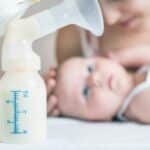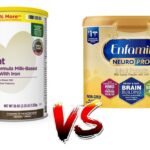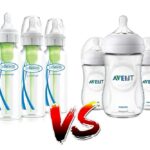If you have spent a long time weighing up the pros and cons of breastfeeding and bottle feeding and you have decided to formula feed your baby, you may be unhappy to hear that the decision-making doesn’t stop there.
Do you know what kind of formula milk you are going to be feeding your baby? The shelves in the grocery store are full of different brands of formula milk, each claiming to be the very best for your baby, do you know which one you are going to use?
It is not just the brand of formula that you need to decide, you also need to choose whether you are going to use powder or liquid formula.
If you are feeling overwhelmed by all the decision-making about milk then fear not, we are here to help.
In this article we explain the differences between powder formula and liquid formula, we highlight the pros and cons of each and give you tips on how to decide which milk is the best option for you and your bottle feeding baby.
What Is Powder Formula?
Powder baby formula often comes in a large canister with a small scoop. Using the preparation guidelines on the packaging, you mix a specific amount of water with the correct number of scoops of powder to create the milk for your baby’s feed.
There is enough powder in a baby formula tin to last several feeds. Different powdered formulas claim to do different things.
You can buy anti-colic formula milk and ‘hungry baby’ powdered formula milk, for example. Many brands of powder formula now include extra ingredients, such as added omega-3, amino acids, and Vitamin D.
- SUPPORT FOR YOUR INFANT - Complete nutrition for babies through 12 months, easy-to-digest proteins and dual prebiotics for immune health
- No.1 PEDIATRICIAN RECOMMENDED INFANT FORMULA - The No.1 trusted brand for brain-building & immune support
Prices pulled from the Amazon Product Advertising API on:
Product prices and availability are accurate as of the date/time indicated and are subject to change. Any price and availability information displayed on [relevant Amazon Site(s), as applicable] at the time of purchase will apply to the purchase of this product.
Pros Of Powder Formula
It is cost-effective
A canister of powder baby formula can last for several feeds. It works out cheaper to use powder formula than to keep buying bottles of ready-to-drink or concentrated liquid formula.
It’s more environmentally friendly
There is less waste with powdered formula as you only have one large tin to dispose of, instead of several plastic bottles of liquid formula. Many of the powdered formula canisters are now reusable making them even more environmentally friendly.
Easy to store
Although the canisters of baby formula can be quite bulky, it is just one product to make space for in your kitchen. If you are using the liquid formula you will need to make space for lots of smaller plastic bottles, especially in the early days when your baby is feeding several times a day.
Long shelf life
Once you have opened a tin of powder formula it is good to use for a month after opening (always check the packaging as different brands may vary). This is particularly useful for breastfeeding moms who may only be using a formula to top up their baby’s feeds once or twice a day.
View in gallery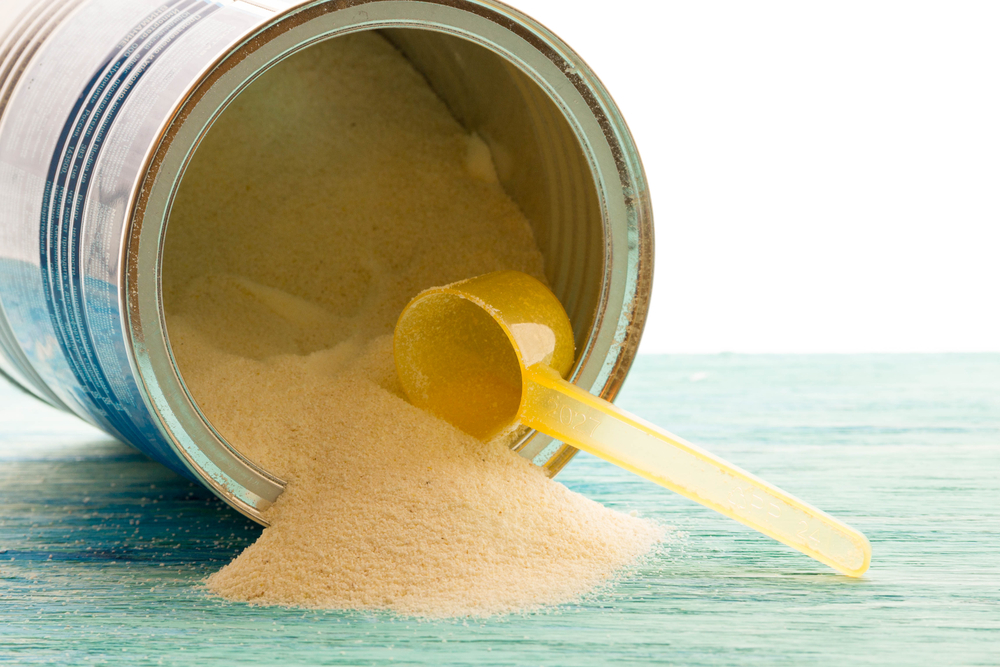
Cons Of Powder Formula
Although powder formula is the cheapest option and the most environmentally friendly, there are some cons to using powder formula that new parents should be aware of.
Precise preparation
Powder formula milk needs to be mixed with water to create the baby’s milk feed.
The process of preparing your baby’s powder formula can be a little time-consuming and feel a bit confusing at the start. Powder formula needs to mixed with water that is sterile to ensure its safe for the baby to drink.
Inconvenient when out and about
As powder formula needs to be mixed with water, it can be a little inconvenient to use when you are not at home with your baby.
You can pre-prepare your baby’s feed but it will only last four hours out of the fridge with a cool pack. It is always best to make your baby’s formula fresh if you can and this isn’t always possible when you are out and about.
Constipation and gas
When you mix powder formula milk with water, bubbles can form when you shake the bottle. Your baby has a greater chance of getting trapped gas because of the air bubbles in their milk.
Other digestive issues like constipation have been linked to the use of powder formula, although this is not the case for all babies.
What Is Liquid Formula Milk?
There are two types of liquid formula milk available for you to buy for your baby: concentrated liquid formula and ready-to-drink liquid formula.
The concentrated liquid formula needs to be mixed with a specific amount of water before you can feed it to your baby. Ready to feed milk does exactly what it says on the tin, the milk is pre-prepared and can be fed straight to your baby.
Unlike powder formula, the ready-to-drink liquid formula can not support certain ingredients and they can not be added to the milk to support your baby’s diet.
- GENTLE NUTRITION: Modeled after the complete nutrition & gentleness of breastmilk, this formula offers soothing nutrition for babies up to 12 months. Comfort for your baby means happiness for all!
Prices pulled from the Amazon Product Advertising API on:
Product prices and availability are accurate as of the date/time indicated and are subject to change. Any price and availability information displayed on [relevant Amazon Site(s), as applicable] at the time of purchase will apply to the purchase of this product.
Pros Of Liquid Formula
No-to-little preparation
Liquid formula does not need to be mixed with water making it super convenient when out and about. The ready-to-drink formula has zero preparation time, you simply pour it into a sterilized feeding bottle and you are all set to feed your baby.
No air bubbles
As the milk has already been prepared without the bottle needing to be shaken to combine the mixture, there should be no tiny air bubbles in the milk. Air bubbles can cause babies to have painful gas so the liquid formula can help your baby avoid this issue.
No concerns about water safety
Powder formula has to be prepared with sterile water and this is not easily accessible for all families. Ready-to-drink formula is already prepared and can be given straight to the baby, you do not need to find or prepare a hygienic and sterile water source first.
It is consistent
Every powder formula feed is going to be the slightest bit different – you shook the bottle for longer one time, added a splash more water the next, or piled the scoop a little higher with powder formula when you prepared another feed.
Ready to feed formula is consistent, the thickness and smoothness of the milk will always be the same.
Cons Of Liquid Formula
It is expensive
The ready-to-feed formula is expensive when compared to the powder formula.
You get a lot more for your money with powder formula and newborn babies can sometimes feed over 10 times a day, cost definitely needs to be taken into consideration when choosing between powder and liquid formula.
View in gallery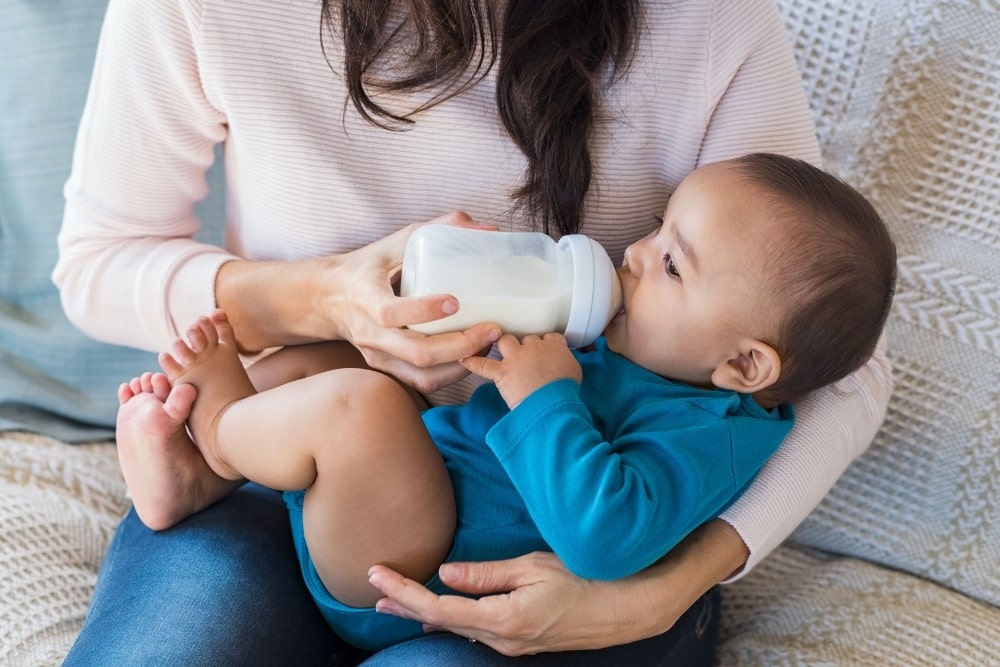
Not environmentally friendly
The liquid formula comes in plastic bottles and we don’t need to tell you that plastic is bad for the planet.
If you are feeding your baby liquid formula at every feed you will be working your way through a lot of plastic. Unfortunately, when it comes to formula feeding what is more convenient for you is more harmful to the environment.
Short shelf life
Once opened, a bottle of ready-to-feed formula will only last 48 hours. If you are only planning on using a little bit of formula at a time, you need to consider this shorter shelf life.
Is Liquid Or Powder Formula Better?
When it comes to which formula milk is more superior, the answer will be different for each family. Circumstances can mean powder is the best choice for one parent but ready to feed wins hands down for another.
In terms of nutritional value, all baby formula milk is regulated by the FDA to ensure its safety and the nutritional value between liquid and powder formula is very similar.
There is also more choice available for powder formula milk, for example, if your baby has certain allergies or acid reflux there are more options when using powder formula.
How To Choose What Formula To Feed Your Baby – 5 Tips
You have all of the details, you know the pros and cons of powder formula vs liquid formula, now here are some tips to help you make the decision of what formula to feed your baby.
Consider the cost
Are you on a tight budget? Do you want to splash out for convenience? These are two important things to think about.
Consider the different shelf lives
Will you be formula feeding only once a day? Will you easily get through a bottle of ready-to-feed formula before it goes bad? It is important to know what shelf life is going to best suit your family circumstances.
Consider the environment
Are you eco-conscious? Are you trying to reduce your plastic waste as a family? The ready-to-feed formula creates more waste than powder formula and if you are on a mission to help the planet, this may influence your decision.
Consider your baby’s dietary requirements
If your baby has certain allergies, food intolerances, or dietary needs, studies have found there are more options available if you use powder formula.
Consider your time
Do you want to be spending time making up 8 – 12 bottles of powder formula a day?
Does the ready-to-feed formula better suit your busy lifestyle? Will you be going out often with your baby and not want to spend time finding somewhere with bottle preparation facilities?
The Final Thought
There is a lot to think about when choosing what formula to feed your baby.
By reading all of the facts in this article and following the tips set out above, you should be able to confidently make a decision on whether powdered formula or liquid formula best suits your family situation and your baby’s need.
For further information why not check out our comparison of two of the biggest baby formula brands Enfamil vs Similac.




